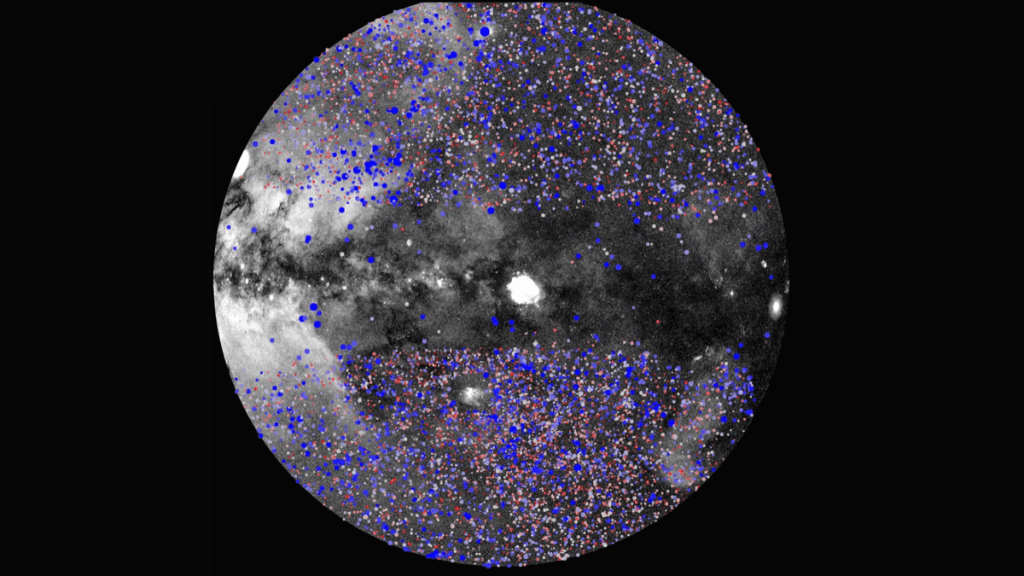
Major X-ray sky survey could relieve crisis surrounding the universe’s ‘lumpiness’ (Image Credit: Space.com)
A new analysis of how galaxy clusters evolved over the 13.8-billion-year history of the cosmos could help solve a long-standing tension surrounding the ‘lumpiness’ of our universe’s matter content. Down the line, it may also help scientists solve a host of other cosmic mysteries.
The first data from the eROSITA all-sky survey of cosmic X-ray sources, which completed 4.5 full sky surveys in February of 2022, contained precision measurements of both the amount of total matter in the universe and the matter’s level of smoothness, or “homogeneity.”
These findings could help resolve a disparity between theoretical predictions of the standard model of cosmology and observations of a cosmic fossil born just after the Big Bang called the cosmic microwave background (CMB). The two, at present, disagree about how lumpy the universe’s matter is.
This disparity has come to be known as the S8 tension, with S8 being the parameter scientists use to quantify the amplitude of matter fluctuations on the scale of around 26 million light-years. In other words, that the lumpiness’ of the cosmos on a vast scale.
While the S8 tension may not be as prominent a problem for cosmology as the “Hubble Tension,” which describes a disparity scientists see in calculations of the universe’s expansion rate, it still represents a brewing storm. It has even been suggested that we may need to find entirely new physics to resolve the conundrum. However, the new eROSITA data offers hope that the S8 tension can be relieved without such drastic measures.
“eROSITA has now established cluster evolution measurement as a tool for precision cosmology,” Esra Bulbul, the lead scientist for eROSITA’s clusters and cosmology team, said in a statement. “The cosmological parameters that we measure from galaxy clusters are consistent with state-of-the-art CMB, showing that the same cosmological model holds from soon after the Big Bang to today.”
Solving a brewing cosmic crisis with eROSITA
The standard model of cosmology, or the “Lambda Cold Dark Matter (ΛCDM) model” suggests that the universe immediately after the Big Bang was a hot and dense sea of photons, or particles of light, and free electrons and protons.
Those electrons are believed to have endlessly scattered photons at this time, meaning the universe would’ve essentially been opaque. That was until around 400,000 years later, when the universe had expanded and cooled enough to allow electrons and protons to get close enough together to bond and create the first atoms of hydrogen.
During this era of reionization, photons were suddenly allowed to travel, and the universe became transparent to light. This “first light” now fills the universe almost perfectly uniformly and is known as the CMB, or the “surface of last scattering.” And because this light has been around since before the first stars and galaxies, the CMB is an excellent tool for tracking how the cosmos has evolved.
As cosmic time progressed, the first atoms clumped to form the first gas clouds, then the first stars, which gathered into galaxies that themselves huddled into the first galactic clusters, ultimately leading to some of the largest structures in the known universe.
Observations of these clusters by eROSITA , the primary instrument on board the Russian-German Spectrum-Roentgen-Gamma (SRG) spacecraft, show that visible matter and dark matter comprise 29% of the total energy density of the universe, consistent with measurements of the CMB.

In observing galactic clusters, eROSITA has also been able to provide a measurement of the lumpiness of matter using the S8 parameter. While prior CMB experiments have suggested a higher value for S8 than the standard model predicts, the eROSITA observations of this cosmic fossil are more in line with those theoretical predictions.
“eROSITA tells us that the universe behaved as expected throughout cosmic history,” Vittorio Ghirardini, research leader and Max Planck Institute for Extraterrestrial Physics postdoctoral researcher, said in the statement. “There’s no tension with the CMB — maybe the cosmologists can relax a bit now.”
Cosmic ghost hunting
eROSITA’s observations of the galactic clusters have also helped scientists learn more about tiny particles called neutrinos, which have so little mass and charge that they basically travel under-the-radar. In fact, 100 trillion of them pass through our bodies every second, unnoticed. Not only does this make neutrinos notoriously difficult to detect, but it has earned them the nickname “ghost particles.”
These particles tiny masses also allow them to race through the cosmos at a speed approaching that of light, with astronomers describing them as “hot” because of this fact. Temperature is essentially a measurement of how fast particles are moving. This means that neutrinos can smooth out the distribution of matter in the universe, and this action can be measured by investigating the evolution of the largest cosmic structures we know of.
Thus, combining eROSITA measurements of galactic clusters with observations of the CMB provided the most refined measurements yet of total neutrino mass value achieved with a cosmological probe.
“It may sound paradoxical, but we have obtained tight constraints on the mass of the lightest known particles from the abundance of the largest dark matter haloes in the universe,” Ghirardini said. “We are even on the brink of a breakthrough to measure the total mass of neutrinos when combined with ground-based neutrino experiments.”
eROSITA’s insights into the universe don’t end there; data from the instrument should be able to reveal the growth rate of the largest structures in the universe too, something predicted by Einstein’s 1915 theory of gravity: General relativity.
An early analysis of 12,247 optically identified clusters of galaxies seen by eROSITA seems to show this growth rate is a little slower in later cosmological times than general relativity predicts.
“We might be at the brink of a new discovery,” Emmanuel Artis, a postdoctoral researcher at the Max Planck Institute for Extraterrestrial Physics, said in the statement. “If it can be confirmed, eROSITA will pave the way for new exciting theories beyond general relativity.”





